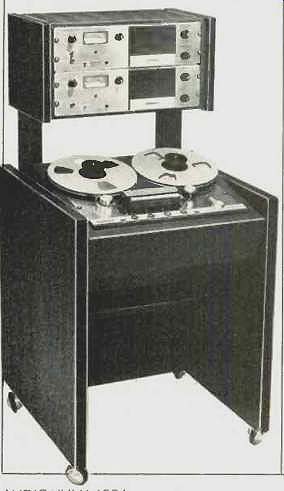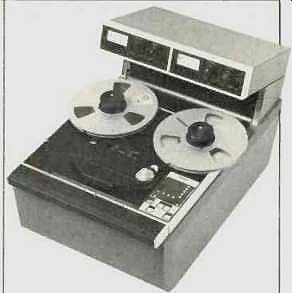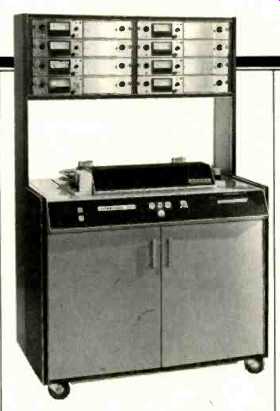UNREEL
A sad and shocking announcement has come from Ampex: After 38 years of production, they will no longer manufacture analog audio magnetic tape recorders. They will continue to manufacture various types of professional video recorders, a field in which they are pre-eminent.
Parts for the many thousands of Ampex Models 350, 300, 440, ATR-100, and their 16- and 24-track magnetic recorders--in use in every corner of the world-will be available for 8 to 10 years.
Thus, an era which began in 1946, with the introduction of the Ampex Model 200, has come to a rather abrupt end. The Model 200 was a re fined, but nonetheless direct descendant of the German Magnetophon, and it had to run at 30 ips to achieve wide frequency response.

---The 350 (1953) and AG-350 (1965) were popular workhorses
In 1950, although I was a sales executive and music director of Magnecord, arch-rival of Ampex. I had quite a few friends at Ampex and always had a very good relationship with the company. Over the years I have either owned or used just about every model of Ampex magnetic tape recorder except the big multi-trackers. Some of the Ampex recorders I used were quite unusual, as you will see from the following.
To combat the growing menace of that upstart, television (which by 1953 had precipitated the closing of many movie theaters), the movie industry came up with Cinemascope, which used a wide-aspect-ratio screen and, in its original embodiment, honest-to God, real, three-channel stereophonic sound. In fact, there even was a fourth channel available for occasional special effects from the rear of the theater.
A notable example was the thunder and earthquake effects during the crucifixion scene in Ben Hur. The original Cinemascope film used stripes of magnetic oxide for each channel, and Ampex made the magnetic heads fit ted to the projector to reproduce these channels. Now, friends, make no mis take, under optimum conditions this system was capable of exceptional high-fidelity stereophonic sound. In fact, in using three discrete channels of sound, it followed the ideas of the famous Bell Telephone/Stokowski stereo experiments of 1933, in which they concluded that three-channel stereo phonic sound afforded the most realistic reproduction of music.
Unfortunately, the repetitive screenings of the films imposed severe wear on the magnetic stripes. Careless projectionists would not clean the heads that were clogged with powdery oxides, which, of course, severely de graded the sound quality.
Another problem with the use of true stereophonic sound in Cinemascope pictures was the extreme difficulty of maintaining a realistic ratio of visual and audio perspectives. This was especially problematic in shifting from close-ups to distant scenes and all variations on this theme. Now that the FCC has approved stereo TV, the same problems could crop up, exacerbated by the small TV screen. How ever, it is doubtful that any attempt will be made to correlate the dynamics of motion with sound. Maybe with the ad vent of wall-size, flat-TV screens this could come to pass . . .?

-----The revolutionary ATR-100 (1976) had no pinch roller.
In its heyday, when Cinemascope still employed three-channel stereo phonic sound, a purely symphonic mini-concert film was presented before the main feature was run. This was done to impress audiences with the sound quality, and most of the time Johnny Green (conductor on many Academy Award shows) and the MGM Symphony Orchestra were shown playing such pieces as "Capriccio Italien." Believe me, through the wide spread left, center and right big-theater loudspeaker systems, it was a mighty impressive sound!
Needless to say, these filmed concerts had to have real three-channel stereophonic master recordings, which would ultimately be transferred to the Cinemascope film. Enter Ampex again.
They supplied a special Model 300, equipped with one of the few three-channel, quarter-inch heads ever made. Through some finagling, I managed to acquire that Ampex three-channel Cinemascope recorder, complete with the "Capriccio Italien" and other tapes, including a Wurlitzer organ recital. I set up three Bozak loud speakers with three McIntosh amplifiers, and wow!--I was absolutely blown away and became an immediate and everlasting champion of three-channel stereophonic sound.
I know you have all heard two-channel stereo systems, with a phantom center channel between your speakers, out when you hear three discrete channels of stereophonic sound, it is simply no contest. With the three channels, you perceive the entire panorama of the symphony orchestra in front of you. There is simply no ambiguity of instrumental positioning; everything is in its proper musical perspective.
There is layered depth and a three dimensional image that is almost palpable.
By 1953, I had been recording two channel stereo and binaural sound for over three years. I had met the late Bob Fine, and when he was making his famous Mercury Olympian Series of monophonic recordings, I was in on those sessions, experimentally recording the music in stereophonic sound.
When Bob decided to convert to stereo recording in 1954, he insisted that it be in the three-channel format. Now, you must remember that in those days there was no such thing as Dolby A or any other kind of noise reduction. In order to maintain good signal-to-noise ratio, Bob wanted to use the three channels on 1-inch-wide tape. One-inch tape was strictly nonstandard, and, try as they might, the several tape manufacturers who furnished the experimental reels had trouble slitting the tape so it would run smoothly over the tape guides and heads. When Bob reduced the tape width to half-inch, all was well, and Ampex began to pro duce Model 300s with three-channel, half-inch heads. This format quickly became standard in the recording industry, and today thousands of three-channel, half-inch master tapes are in the vaults of the record companies vast repositories of musical treasures.
Perhaps with further development of the digital processing system, devised by Roger Lagadec of Studer to remove noise from analog recordings without degradation of the music (described in the January issue of Audio), many of these great recordings could offer new musical riches.
Ampex made thousands of the three-channel, half-inch recorders. In 1958, when Harry Belock and I founded Everest Records, we ordered three and modified them with special low-noise electronics. I made many recordings with the London Symphony Orchestra and the London Philharmonic Orchestra and used these Ampex recorders until we pioneered the use of 35-mm, three-channel magnetic film.
(Several years later, we sold this 35-mm equipment to Bob Fine.)

------------
The MM-1000 (1968) came in 8-, 16-, and 24-track versions.
I have a number of copies of some of my Everest three-channel, half-inch masters and a three-channel, half-inch head for my Ampex 440C. A few years ago, I invited my good friend Lee Kuby (a very keen-eared tape and music enthusiast who was product development manager for Harman/Kardon for many years and now is with Infinity/ JBL) to come to my home for a listening session. I set up the three-channel heads on the Ampex, with B & W 801s on the left and the right and a B & W 802 in the center. I drove the left and right 801s with a Levinson ML-3 amplifier and the 802 with one channel of another ML-3. Then I threaded the Ampex with a three-channel, half-inch tape of Rachmaninoff's "Symphonic Dances," which I had recorded with the London Symphony Orchestra con ducted by Sir Eugene Goossens. Lee had never heard three-channel stereo, and he reacted as I knew he would with amazement and delight. Of course, he became a new convert. But then I went a step further and added in the side and rear speakers in my Benchmark delay system. The three channels up front plus the delay system reproduced music with what can only be described as mind-boggling realism! Just think, friends-the Compact Disc could conceivably be for matted to provide three channels of totally discrete stereo sound! If any enterprising record company wants to engineer three-channel stereo digital recordings, I am, in a modest way, available.
Through the years, Ampex built an enviable reputation for the high quality and reliability of their magnetic tape recorders. The MM-1000, a 16-channel recorder, really pioneered the concepts behind today's multi-track technology. Alas, in the past several years, rising parts and labor costs and a de cline in reliability has not helped matters. Combine this with the failure of Ampex to launch a contender into the digital derby, and it spelled trouble.
Undoubtedly, with the availability of parts and some tender loving care, most Ampex recorders still have many years of useful life. However, the demise of the Ampex audio tape-recorder division may be the handwriting on the wall. Is the Ampex failure the first nail in the analog magnetic-tape coffin? Professionally, analog tape machines are available from Studer, Sony/ MCI, Telefunken, Magnetophon, Otari, Lyrec, Schlumberger and Philips. In the consumer area, open-reel tape recorders are still available from Akai, Nagra, Revox, Teac, Technics, Otari and several other Japanese companies. John Crocker and Tony Barclay, those two indefatigable champions of prerecorded open-reel tapes, continue to issue excellent dupes from their Barclay-Crocker Laboratories, newly located in Poughkeepsie, N.Y.
No doubt, analog tape recorders will continue to be used for many years.
But it would be foolish to ignore the signs and portents pointing to ever increasing use of digital recording technology. Except for some independent engineers and smaller record companies, virtually all classical-music recording by the major labels is now digitally mastered. A great deal of pop recording is also digitally mastered, al though, here, the multi-track analog recorder is still very strong.
It is in the consumer market that open-reel analog recorders must be considered to be in great peril. The pressures from high-quality cassette recorders (and the vast catalog of pre-recorded cassettes), plus the availability of low-cost digital processors and VCRs and the possibility of recordable Compact Discs a few years down the road, all point to hard times for open-reel analog tape recorders.
(adapted from Audio magazine, Bert Whyte)
= = = =